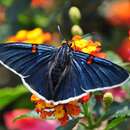en
names in breadcrumbs


Phocides polybius, the bloody spot or guava skipper, is a species of butterfly in the skipper family, Hesperiidae, that is native to the Americas. It is found from the lower Rio Grande Valley of southern Texas in the United States south through Mexico and Central America to Argentina. The species was first described by Johan Christian Fabricius in 1793.
The wingspan is 42–63 mm (1.7–2.5 in). There are several generations with adults on wing in February, April, and June to December in southern Texas.[1]
The larvae feed on Psidium species, including Psidium guajava and Psidium cattleianum. Adults probably feed on flower nectar.[1]
Phocides polybius, the bloody spot or guava skipper, is a species of butterfly in the skipper family, Hesperiidae, that is native to the Americas. It is found from the lower Rio Grande Valley of southern Texas in the United States south through Mexico and Central America to Argentina. The species was first described by Johan Christian Fabricius in 1793.

The wingspan is 42–63 mm (1.7–2.5 in). There are several generations with adults on wing in February, April, and June to December in southern Texas.
The larvae feed on Psidium species, including Psidium guajava and Psidium cattleianum. Adults probably feed on flower nectar.